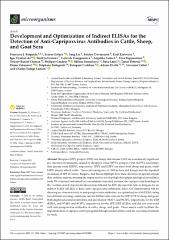Development and Optimization of Indirect ELISAs for the Detection of Anti-Capripoxvirus Antibodies in Cattle, Sheep, and Goat Sera
| dc.contributor.author | Berguido, Francisco J. | |
| dc.contributor.author | Gelaye, Esayas | |
| dc.contributor.author | Liu, Yang | |
| dc.contributor.author | Davaasuren, Batdorj | |
| dc.contributor.author | Krstevski, Kiril | |
| dc.contributor.author | Djadjovski, Igor | |
| dc.contributor.author | Ivanova, Emiliya | |
| dc.contributor.author | Goujgoulova, Gabriela | |
| dc.contributor.author | Loitsch, Angelika | |
| dc.contributor.author | Tuppurainen, Eeva | |
| dc.contributor.author | Chibssa, Tesfaye Rufael | |
| dc.contributor.author | Caufour, Philippe | |
| dc.contributor.author | Samojlović, Milena | |
| dc.contributor.author | Lazić, Sava | |
| dc.contributor.author | Petrović, Tamaš | |
| dc.contributor.author | Vidanović, Dejan | |
| dc.contributor.author | Bertagnoli, Stéphane | |
| dc.contributor.author | Grabherr, Reingard | |
| dc.contributor.author | Diallo, Adama | |
| dc.contributor.author | Cattoli, Giovanni | |
| dc.contributor.author | Lamien, Charles Euloge | |
| dc.date.accessioned | 2022-11-26T08:37:52Z | |
| dc.date.available | 2022-11-26T08:37:52Z | |
| dc.date.issued | 2022 | |
| dc.identifier.issn | 2076-2607 | |
| dc.identifier.uri | https://repo.niv.ns.ac.rs/xmlui/handle/123456789/570 | |
| dc.description.abstract | Sheeppox (SPP), goatpox (GTP), and lumpy skin disease (LSD) are economically significant pox diseases of ruminants, caused by sheeppox virus (SPPV), goatpox virus (GTPV), and lumpy skin disease virus (LSDV), respectively. SPPV and GTPV can infect both sheep and goats, while LSDV mainly affects cattle. The recent emergence of LSD in Asia and Europe and the repeated incursions of SPP in Greece, Bulgaria, and Russia highlight how these diseases can spread outside their endemic regions, stressing the urgent need to develop high-throughput serological surveillance tools. We expressed and tested two recombinant truncated proteins, the capripoxvirus homologs of the vaccinia virus C-type lectin-like protein A34 and the EEV glycoprotein A36, as antigens for an indirect ELISA (iELISA) to detect anti-capripoxvirus antibodies. Since A34 outperformed A36 by showing no cross-reactivity to anti-parapoxvirus antibodies, we optimized an A34 iELISA using two different working conditions, one for LSD in cattle and one for SPP/GTP in sheep and goats. Both displayed sound sensitivities and specificities: 98.81% and 98.72%, respectively, for the LSD iELISA, and 97.68% and 95.35%, respectively, for the SPP/GTP iELISA, and did not cross-react with anti-parapoxvirus antibodies of cattle, sheep, and goats. These assays could facilitate the implementation of capripox control programs through serosurveillance and the screening of animals for trade. | en_US |
| dc.description.sponsorship | This study was supported by funds received from the government of Japan for the IAEA Peaceful Uses Initiative (Project “Detection of emerging and re-emerging animal and zoonotic pathogens at the animal-human interface”). | en_US |
| dc.language.iso | en | en_US |
| dc.source | Microorganisms | en |
| dc.subject | capripoxvirus | en_US |
| dc.subject | iELISA | en_US |
| dc.subject | A34 | en_US |
| dc.subject | A36 | en_US |
| dc.subject | LSDV | en_US |
| dc.subject | SPPV | en_US |
| dc.subject | GTPV | en_US |
| dc.title | Development and Optimization of Indirect ELISAs for the Detection of Anti-Capripoxvirus Antibodies in Cattle, Sheep, and Goat Sera | en_US |
| dc.type | Article | en_US |
| dc.identifier.doi | 10.3390/microorganisms10101956 |
Files in this item
This item appears in the following Collection(s)
-
Naučni radovi
Radovi objavljeni u naučnim časopisima

